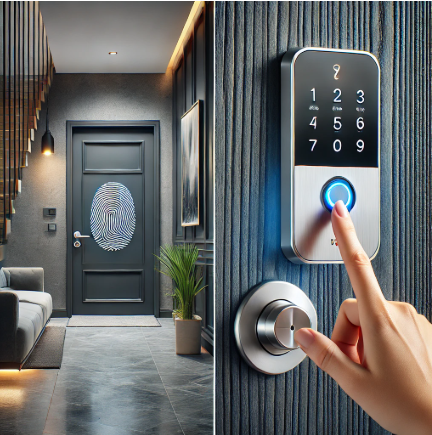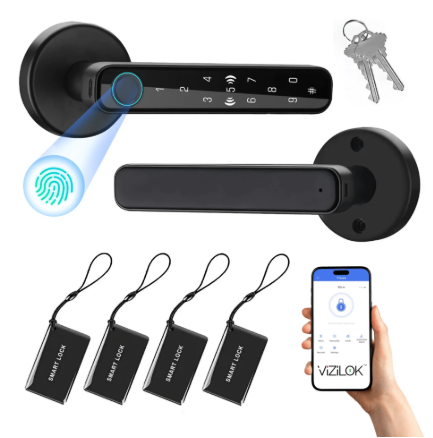Deciding between fingerprint vs keypad smart locks is key to securing your home with the right technology in 2025. A smart lock is an electronic lock that connects to your smartphone or smart home system via WiFi or Bluetooth, offering keyless entry through fingerprint scanning or PIN codes. Fingerprint vs keypad smart locks each have unique advantages: fingerprint locks offer personalized, high-security access, while keypad locks provide flexibility for multiple users without physical keys.
Why focus on fingerprint vs keypad smart locks? Understanding their differences helps you choose the best fit for your needs, whether prioritizing speed or versatility. This beginner-friendly smart lock setup guide covers smart lock installation, app connection, and troubleshooting for both types, tailored for wooden doors. Whether you’re new to DIY smart lock installation or upgrading your smart home, this guide ensures you can install smart lock on wooden door and make an informed choice. Let’s get started!

What You Need Before Installing
Before diving into fingerprint vs keypad smart locks, preparation ensures a smooth smart lock installation. Gathering tools and checking compatibility sets the stage for a successful DIY smart lock installation on wooden doors.
Tools Required: Both fingerprint and keypad smart locks require similar tools for installation, including:
- Phillips screwdriver (sizes #1 and #2) for securing and removing screws.
- Flathead screwdriver for prying off old hardware.
- Tape measure to verify door dimensions.
- Drill with bits (if modifications are needed, though most fit standard deadbolt holes).
- Pencil for marking alignments.
- Optional: Level for straight installation and safety glasses.
These tools support install smart lock on wooden door. Check the smart lock user guide for specific requirements, as brands like Ultraloq (fingerprint) and Schlage (keypad) provide detailed instructions.
Compatibility Checks: Confirm your door’s suitability for fingerprint vs keypad smart locks. Wooden doors typically have standard deadbolt holes (2-1/8-inch face bore, 1-inch edge bore) and thicknesses of 1-3/8 to 2 inches. Ensure the wood is solid around the lock area. For connect smart lock to WiFi or Bluetooth, verify your phone (iOS or Android) supports the lock’s app, crucial for fingerprint programming or PIN management. Test WiFi signal strength at the door (use 2.4GHz, as many locks don’t support 5GHz). Check compatibility with smart home hubs like Alexa or HomeKit, especially for fingerprint models like Yale. Keypad locks are often simpler for renters, requiring no biometric setup.
Power Needs: Both types use four AA or AAA alkaline batteries, lasting 6-12 months. Fingerprint locks may drain slightly faster due to sensor use. Keep spares for smart lock battery replacement. Some models include physical keys or 9V battery terminals for backup. Choose weatherproof locks for exterior doors to protect fingerprint sensors or keypads. Review the smart lock user guide for details, as brands like Ultraloq and Schlage offer app-based tutorials. Preparation takes 15-20 minutes but ensures a reliable smart lock setup guide.
Step-by-Step Installation Guide
This guide on fingerprint vs keypad smart locks covers the full smart lock installation process for wooden doors, highlighting differences in setup and troubleshooting for both types.
Step 1: Removing the Old Lock
Begin by replacing door lock with smart lock, whether fingerprint or keypad.
- Open the door for access to both sides. Locate screws on the interior thumb turn or plate.
- Use a Phillips screwdriver to remove screws and detach the interior assembly.
- Slide the deadbolt mechanism out from the door’s edge.
- Remove the exterior cylinder or knob, unscrewing fasteners. Use the key if needed.
- Unscrew the strike plate from the door frame, keeping parts for renters to restore later.
This takes 5-10 minutes. If stuck, gently pry with a flathead screwdriver, avoiding damage to the wood for install smart lock on wooden door.
Step 2: Preparing the Door
Prepare the door for your new smart lock.
- Clean the deadbolt hole with a vacuum or cloth to remove debris.
- Verify borehole sizes (2-1/8-inch face, 1-inch edge). Adjust with a drill if needed, though most locks fit standard setups.
- Test-fit the new deadbolt, ensuring smooth operation.
This step takes 5-10 minutes and is critical for install smart lock on wooden door to prevent misalignment for either lock type.
Step 3: Installing the Smart Lock
Mount the smart lock hardware.
- Insert the deadbolt into the edge hole, aligning “up” markings, and secure with screws.
- Attach the exterior assembly (fingerprint sensor or keypad), feeding cables through the borehole if applicable.
- Secure the interior mounting plate, connecting cables to the interior unit.
- Attach the interior assembly over the plate and screw it in place.
- Install the strike plate on the door frame, aligning with the deadbolt.
Follow the smart lock user guide for model-specific instructions (e.g., Ultraloq U-Bolt Pro for fingerprint or Schlage Encode for keypad). This takes 20-30 minutes. Fingerprint sensors require careful alignment for accessibility.
Step 4: Connecting with the App and Phone
App setup is essential for both types in fingerprint vs keypad smart locks. This step focuses on smart lock app connection.
- Download the manufacturer’s app (e.g., Ultraloq, Schlage Home, Yale Access) from the App Store or Google Play.
- Create an account and follow prompts to add a new device.
- Put the lock in pairing mode, typically by pressing a button on the interior unit (see smart lock user guide).
- For WiFi models, connect smart lock to WiFi: Select your 2.4GHz network, enter credentials, and wait for confirmation. Bluetooth models pair directly with your phone.
- Calibrate lock/unlock functions and enable features like auto-lock or notifications.
- Test connectivity by locking/unlocking via the app.
Ensure your phone’s WiFi or Bluetooth is active and you’re near the door. Use a WiFi extender if signals are weak. This takes 10-15 minutes.
Step 5: Setting Up Fingerprint or Keypad Access
Configure access based on your choice in fingerprint vs keypad smart locks.
- For fingerprint locks: Open the app, navigate to “Fingerprint Management,” and scan your finger (2-3 scans for accuracy). Assign fingerprints to user profiles and test on the sensor.
- For keypad locks: Open the app, navigate to “PIN Management,” and create unique 4-8 digit codes for each user. Set temporary codes for guests if needed.
- Enable activity logs to track entries for security.
- Test access: Use fingerprints for fingerprint locks or enter PINs for keypad locks.
- For fingerprint locks, clean the sensor with a soft cloth to maintain accuracy.
This step takes 5-10 minutes per user. Fingerprint locks offer personalized access, while keypad locks support multiple users easily.
Step 6: Testing Functionality and Troubleshooting
Test the lock to ensure reliability for fingerprint vs keypad smart locks.
- Manually lock/unlock from both sides to confirm smooth operation.
- Test fingerprint scanning (for fingerprint locks) or PIN entry (for keypad locks).
- Use the app to lock/unlock remotely (WiFi models) or via Bluetooth.
- Verify notifications for door activity in the app.
- Test smart home integration (e.g., Alexa, HomeKit) if supported.
smart lock troubleshooting for both types:
- Fingerprint Issues: Re-register fingerprints with clean, dry fingers. Clean the sensor with a soft cloth.
- Keypad Issues: Re-enter PINs via the app. Ensure codes are active.
- App Connection Issues: Restart the app and lock. Ensure a 2.4GHz network for connect smart lock to WiFi. Keep phones within 30 feet for Bluetooth.
- Deadbolt Sticking: Realign the strike plate or lubricate with graphite spray.
- Battery Drain: Perform smart lock battery replacement with fresh AA/AAA batteries. Disable unused notifications to extend battery life.
Testing and troubleshooting take 10-15 minutes, ensuring your chosen lock type performs reliably.

Tips for Successful Installation
With your guide on fingerprint vs keypad smart locks complete, these tips ensure a lasting DIY smart lock installation and optimal performance.
Security Considerations: Choose a smart lock with strong encryption (e.g., AES-128) to prevent hacking, a key factor in fingerprint vs keypad smart locks. Enable two-factor authentication in the app. Use complex PINs for keypad locks or limit fingerprint access to trusted users. Update firmware regularly. For exterior wooden doors, select weatherproof models to protect sensors or keypads.
WiFi/Bluetooth Signal Placement: Position the lock where signals are strong. Wooden doors don’t interfere like metal, but test connectivity for connect smart lock to WiFi. Use a WiFi extender for reliable app control. For Bluetooth models, ensure phones are within 30 feet.
Safety Precautions: Install with the door open to avoid lockouts. Store the backup key securely and inform trusted users of its location. For smart lock battery replacement, set reminders every 6 months (sooner for fingerprint locks) and use app alerts to monitor levels.
Additional Tips: For keypad locks, use temporary PINs for guests. For fingerprint locks, register multiple fingers per user for flexibility. Integrate with smart home devices for automation (e.g., lights on unlock). Sync multiple locks for centralized control. These tips enhance your smart lock setup guide and optimize your choice in fingerprint vs keypad smart locks.
Frequently Asked Questions
Questions about fingerprint vs keypad smart locks? Here are answers to common concerns.
What Happens When the Battery Dies?
Most locks include a physical key for backup. Some support 9V battery terminals for temporary power. App alerts notify you for smart lock battery replacement. Use fresh alkaline batteries.
Does It Work Without Internet?
Yes, fingerprint and keypad functions work offline. WiFi-dependent features like remote access require internet, a key consideration in fingerprint vs keypad smart locks.
Do You Need Professional Installation?
No, this DIY smart lock installation guide suits most users. Professionals are only needed for complex doors, saving $50-150.
Additional FAQs: For smart lock troubleshooting, check app error codes or contact support. Fingerprint issues? Re-register or clean the sensor. Keypad issues? Verify PINs in the app.
Conclusion
Choosing between fingerprint vs keypad smart locks in 2025 allows you to tailor your home security to your needs. This smart lock installation guide covers smart lock app connection, setup, and troubleshooting, empowering you to install smart lock on wooden door with ease. Fingerprint locks offer personalized security, while keypad locks provide versatile access for multiple users.
Embrace the DIY approach—it’s cost-effective and straightforward. Ready to upgrade your home? Visit smart lock to explore top models in fingerprint vs keypad smart locks and elevate your smart home today!